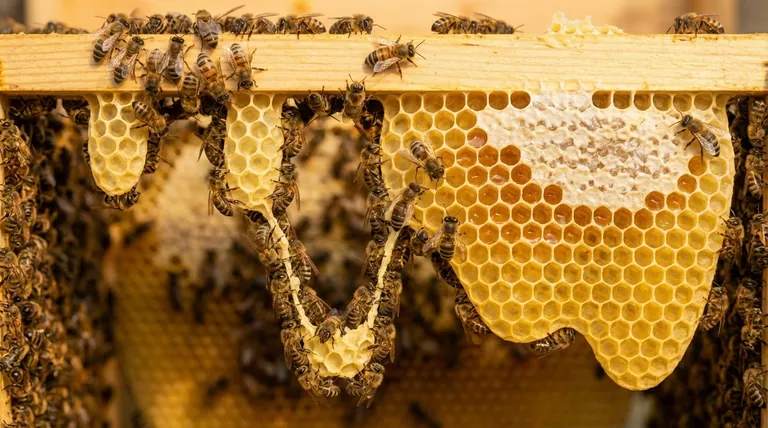To build honeycomb, honeybees form living chains by linking their legs together, creating a scaffold from which they work. Young worker bees secrete flakes of beeswax from special glands, which they then chew and manipulate with their mandibles to meticulously construct the hexagonal cells that make up the comb.
The construction of honeycomb is a marvel of collective engineering; it is not simply a structure for storing honey, but a multi-purpose nursery and pantry precisely designed to raise young and sustain the entire colony through winter.

The Foundation: From Gland to Building Block
The entire honeycomb structure begins with the bees' innate ability to produce their own building material: beeswax. This process is a specialized task performed by specific members of the hive.
The Role of Young Worker Bees
Only young worker bees, typically between 12 and 20 days old, are the primary wax producers. Their bodies are biologically optimized for this task, which they lose as they age and take on other roles like foraging.
Secreting Wax Flakes
These specialized bees have eight wax-producing glands on the underside of their abdomens. They consume large amounts of honey, which their bodies convert into energy to fuel these glands, eventually secreting tiny, clear flakes of wax.
Preparing the Wax for Construction
The raw wax flakes are brittle. To make them pliable, bees pass the flakes to their mandibles, chew them, and mix them with saliva. This process turns the wax into a workable material, ready for sculpting.
The Architectural Process
With building materials ready, the colony begins the highly organized process of construction. This is a cooperative effort that relies on instinct and environmental cues.
Forming Chains and Scaffolds
Bees initiate construction by clinging to each other, forming intricate living chains and lattices. This "scaffolding" provides the stability and measurement framework needed to build the comb with remarkable precision.
Building From the Top Down
Construction always starts from the ceiling of the hive cavity and progresses downwards. Bees meticulously place and shape the pliable wax to form the initial hexagonal cells, which serve as the foundation for the rest of the comb.
The Importance of Temperature
The hive's internal temperature is critical. Worker bees maintain a temperature of around 95°F (35°C), which keeps the beeswax at the perfect consistency—soft enough to be molded but firm enough to hold its shape.
A Purpose-Built Structure
Honeycomb is not a uniform structure. It contains different cell sizes, each engineered for a specific function vital to the colony's survival and growth.
Worker Cells for the Majority
The vast majority of cells are worker-sized. These are the smaller, standard hexagonal cells used for two primary purposes: raising new female worker bees and storing honey and pollen.
Drone Cells for the Males
Bees also construct larger cells known as drone cells. These are built specifically to accommodate the larger size of male drone bees as they develop from egg to adult.
The Hexagonal Advantage
The iconic hexagonal shape is no accident. It is the most efficient shape in nature, allowing bees to store the maximum amount of honey with the minimum amount of wax, creating a structure that is both lightweight and incredibly strong.
From Construction to Use
Once the cells are built, they are immediately put to use for the colony's two most critical needs: food storage and raising the next generation.
Storing Nectar and Pollen
Foraging bees return to the hive and deposit nectar and pollen into empty cells. The nectar is the raw ingredient for honey.
Sealing the Finished Honey
Bees dehydrate the nectar by fanning it with their wings until it reaches the right moisture content. Once it has been converted to honey, they seal the cell with a fresh wax cap, preserving it for future use.
How to Interpret Honeycomb Construction
Based on your interest, the process of building honeycomb reveals different insights into the life of a honeybee colony.
- If your primary focus is bee biology: The key takeaway is that honeycomb is a direct and dynamic expression of the colony's health, resources, and reproductive needs.
- If your primary focus is practical beekeeping: Recognizing the difference between worker and drone cells is crucial for assessing the queen's laying pattern and the overall balance of the colony.
Honeycomb construction is the physical manifestation of a honeybee colony's collective instinct and intelligence.
Summary Table:
| Stage | Key Process | Primary Actors |
|---|---|---|
| Foundation | Wax secretion from glands | Young worker bees (12-20 days old) |
| Architecture | Building hexagonal cells from the top down | Worker bees forming living chains |
| Purpose | Storage (honey/pollen) & raising brood (workers/drones) | Entire colony |
| Key Factor | Maintaining hive temperature at ~95°F (35°C) | Worker bees regulating heat |
Fascinated by the engineering of a honeybee colony? For commercial apiaries and beekeeping equipment distributors, efficient hive management is key to productivity. HONESTBEE supplies the durable, high-quality beekeeping supplies and equipment you need to support healthy colonies and maximize your honey yield. Contact HONESTBEE today to learn more about our wholesale-focused solutions and how we can help your operation thrive.
Visual Guide

Related Products
- Beeswax Foundation Sheets Beehive Foundation for Wholesale
- Notebook Style Beeswax Foundation Mould Wax Foundation Mold
- Manual Beeswax Comb Foundation Machine Wax Foundation Mill Embossing Machine
- Electric Beeswax Flat Sheet Machine with Operating Tray for Wax Processing
- Electric Beeswax Foundation Machine With Operating Tray and Wax Foundation Roller
People Also Ask
- What happens after the flattening and embossing process is complete? From Molten Wax to Solid Foundation
- How do beeswax foundations save bees time and energy? Boost Hive Productivity & Honey Yield
- What is beeswax foundation used for? A Guide to Efficient Hive Management
- What are wax sheets made of? A Guide to Pure Beeswax Foundation for Healthy Hives
- What happens if foundation is given to colonies during a nectar dearth? Avoid Wasted Equipment and Stressed Bees



















